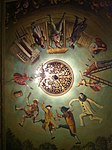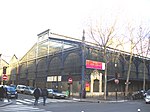Filles du Calvaire (Paris Métro)
Paris Métro line 8Paris Métro stations in the 11th arrondissement of ParisParis Métro stations in the 3rd arrondissement of ParisParis Métro stubsRailway stations in France opened in 1931

Filles du Calvaire (French pronunciation: [fij dy kalvɛːʁ]) is a station on line 8 of the Paris Métro, named after the Boulevard des Filles du Calvaire. The station opened on 5 May 1931 with the extension of the line from Richelieu - Drouot to Porte de Charenton. The boulevard was named after the Calvairiennes or Filles du Calvaire (Daughters of Calvary) who were an order of reformed Benedictine sisters. Antoinette d’Orléans and Père Joseph founded the order in Poitiers, in 1617. The convent was later moved to Paris and was closed in the French Revolution.
Excerpt from the Wikipedia article Filles du Calvaire (Paris Métro) (License: CC BY-SA 3.0, Authors, Images).Filles du Calvaire (Paris Métro)
Boulevard du Temple, Paris 11th Arrondissement (Paris)
Geographical coordinates (GPS) Address Nearby Places Show on map
Geographical coordinates (GPS)
| Latitude | Longitude |
|---|---|
| N 48.864166666667 ° | E 2.3661111111111 ° |
Address
Temple - Jean-Pierre Timbaud
Boulevard du Temple
Paris, 11th Arrondissement (Paris)
Ile-de-France, France
Open on Google Maps











